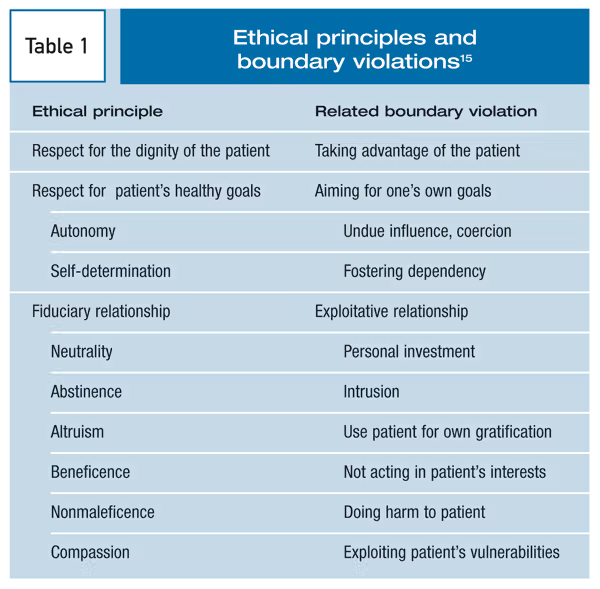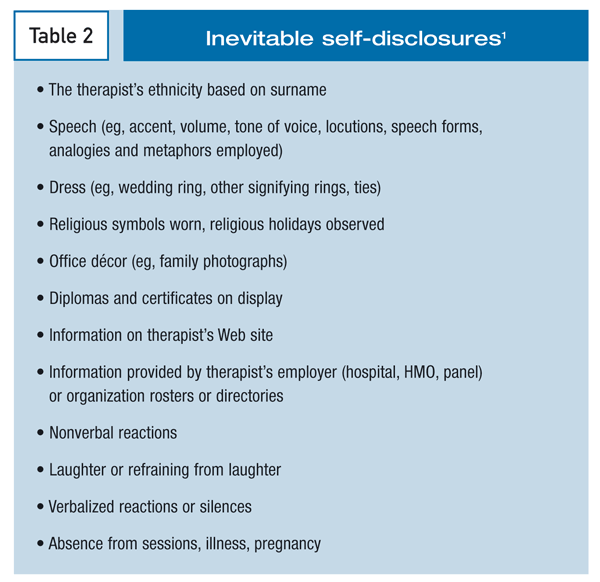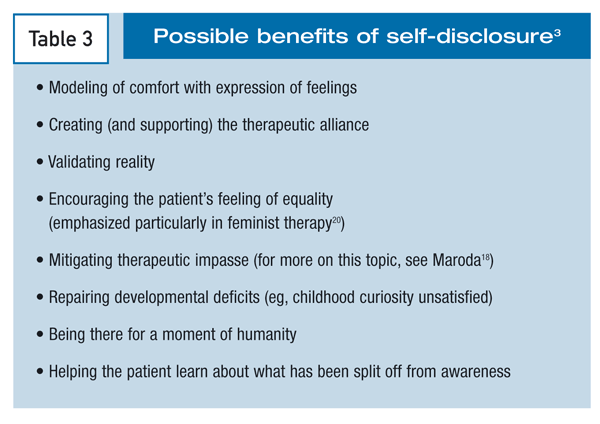Publication
Article
Psychiatric Times
Ethical Aspects of Self-Disclosure in Psychotherapy
Author(s):
The issue of self-disclosure in psychotherapy is one of complexity and some evolution.1-16 Most discussions about the practice refer to boundary questions because self-disclosure by the therapist to the patient is a boundary issue. Self-disclosure has, of course, a number of dimensions, including clinical, therapeutic, technical and-in some cases-legal or regulatory. Despite the rich and interesting clinical issues relating to self-disclosure (outlined in Gutheil and Brodsky1), the focus of this article is on the ethical aspects of self-disclosure.1,15,16 Of necessity, the discussion centers on the more exploratory forms of psychotherapy, such as dynamic therapy, rather than on behavioral therapies, co-counseling, substance abuse treatment, or pharmacological treatment.
Table 1 - Ethical principles and boundary violations

Table 2 - Inevitable self-disclosures

Table 3 - Possible benefits of self-disclosure


The issue of self-disclosure in psychotherapy is one of complexity and some evolution.1-16 Most discussions about the practice refer to boundary questions because self-disclosure by the therapist to the patient is a boundary issue. Self-disclosure has, of course, a number of dimensions, including clinical, therapeutic, technical and-in some cases-legal or regulatory. Despite the rich and interesting clinical issues relating to self-disclosure (outlined in Gutheil and Brodsky1), the focus of this article is on the ethical aspects of self-disclosure.1,15,16 Of necessity, the discussion centers on the more exploratory forms of psychotherapy, such as dynamic therapy, rather than on behavioral therapies, co-counseling, substance abuse treatment, or pharmacological treatment.
Relevant ethical principles
In considering ethical aspects of self-disclosure, we should identify the most relevant principles, which are:
• Beneficence (doing good for the patient)
• Nonmaleficence (doing no harm)
• The fiduciary relationship between clinician and patient, where the interests and welfare of the patient always predominate
These 3 principles share the purpose of undertaking therapeutic interventions to benefit the patient, not the therapist. Indeed, respecting the dignity of the patient is the sovereign ethical principle that guides all the others. Compassion, neutrality, altruism, autonomy, and abstinence from personal gratification may also be invoked in resolving dilemmas regarding self-disclosure.
In contradistinction to the ethical principles above, we may identify a number of potentially unethical motivations for self-disclosure. Therapists can violate the above principles through self-disclosure that is ex-cessive, seductive, exploitative, or narcissistic/exhibitionistic. Unethical self-disclosure may also occur because the therapist wishes solely to unburden himself or herself of some concern, with no foreseeable benefit to the patient.
Table 1 outlines how ethical principles may be correlated with boundary violations (the latter defined in more detail below).
A typology of self-disclosure
Self-disclosure manifests itself in 3 major forms in actual clinical practice. One form is inevitable self-disclosures. A number of self-disclosures occur with no possibility of avoiding them (Table 2). These may or may not be problematic but may well enter into the therapeutic discourse. Therapists, as it were, are broadcasting on the international social awareness frequency at every moment of the relationship, and patients have receivers of variable bandwidth. Some of these disclosures may be unconscious:
The well-known psychoanalyst Ralph Greenson in 1967 admitted that his patient actually figured out that Dr Greenson was a liberal Democrat. Greenson, who thought he was practicing anonymity, asked, “How is that?” The patient explained that when he mentioned anything positive about Roosevelt, Greenson was silent. If the patient said anything negative about Roosevelt, Greenson asked for his associations, implying that not liking Roosevelt was an infantile feeling. . . . Greenson’s response to being discovered was both chagrin and the realization that pure anonymity was impossible.3
Accidental self-disclosures are extratherapeutic encounters, slips of the tongue, public notices of lectures, obituaries, and so on. Personal aspects of the therapist’s life come to light because the therapist calls a patient by another patient’s name, a newspaper prints an obituary of the therapist’s spouse, or the therapist is seen entering a place of worship.
CHECKPOINTS
• The 3 principles most relevant to ethical aspects of self-disclosure are beneficence; nonmaleficence; and the fiduciary relationship between clinician and patient, where the interests and welfare of the patient always predominate.
• Intentional self-disclosures may be clinically based and therapeutic, supportive and alliance-building; or they may be seductive, exhibitionistic, care-seeking, and the like.
• Patients may be ambivalent about having personal questions answered: the therapist’s task is to explore and determine whether the patient truly needs to hear the answer to prevent a therapeutic impasse.
Intentional self-disclosures occur during the session. They may be clinically based and therapeutic, supportive and alliance-building; or they may be seductive, exhibitionistic, care-seeking, and the like. Modern social networking systems (eg, Facebook, MySpace) exemplify intentional self-disclosure without a particular patient focus. In contrast, Internet search engines (eg, Google, LexisNexis) may allow unintended disclosure of personal details of the therapist’s life.
A therapist told a patient that he had to postpone their next session because of illness in his family; another postponement followed when the therapist’s relative died. After each of these absences the patient said, “I’m not going to ask you anything about this, but are you all right?” That was an appropriate thing for the patient to say, but in retrospect the therapist felt that he had burdened the patient unnecessarily by sharing his personal misfortune with the patient. It shifted the focus of need and care from the patient to the therapist.1(pp120-121)
Distinctions are often drawn between intra- and extra-session disclosure. The former appears to provoke fewer ethical conflicts than when the therapist brings in personal material from “outside.” For example, saying to a patient, “I feel as though you are shutting me out today; why might that be?” proffers a disclosure of the therapist’s personal feelings in a way that encourages clinical exploration. In contrast, comments along the generic lines of “A funny thing happened to me the other day” merit some doubt about their clinical value and utility.
Everything a therapist does or does not say is a disclosure, but not necessarily an inappropriate one.1 - by Thomas G. Gutheil, MD
A critical criterion
In this area as in all matters involving possible boundary problems, context is the most important determinant in assessing the appropriateness and ethical valence of self-disclosure.1,9,10 First, different schools of therapeutic practice may have different teachings about self-disclosure; classical psychoanalysis, client-centered therapy, existential therapy, and reality therapy may place different weights on the therapist’s transparency. Second, different patients with different diagnoses, as well as the same patients at different stages of therapy, may require different decision making about self-disclosure. Third, the therapist’s motivation and intent are critical factors in weighing the ethical force of self-disclosure, particularly whether the goal of such disclosure is primarily for the patient’s benefit.
Self-disclosure as a boundary matter
As noted elsewhere, boundary issues like self-disclosure may be divided into 2 categories with ethical implications.1,9,10 Boundary crossings represent departures from usual therapeutic practice that do not harm the patient or the therapeutic work (the principle of nonmaleficence). Boundary violations, in contrast, depart from usual practice but have the effect of harming the patient, often (but not always) in the form of exploitation of the patient. For example, a therapist who states, “I am having such intense sexual feelings for you I can barely stay in my chair” is clearly being seductive while intruding personal issues into the therapy. Although context is still determinative, in most cases the therapist’s disclosure of sexual feelings usually burdens, alienates, inflames, frightens, or intimidates the patient.
Furthermore, the fiduciary obligations of the therapist require that he take responsibility for setting and maintaining the boundaries, even against pressure from the patient to transgress them.
It is important to consider that self-disclosure may have specific benefits in context, when clearly done for the particular patient’s benefit. Some of these benefits are listed in Table 3.
Non–self-disclosure
Nondisclosure, or refusal to disclose when asked, is also a disclosure, eg, of a posture toward the patient, of a distant or ungiving persona, of a theoretical orientation, or of withholding. Moreover, the patient’s ability to tolerate and use nondisclosure for therapeutic advantage may depend heavily on how the therapist couches the refusal to disclose on request. It is one thing to turn the patients’ queries perpetually back on themselves (“Where do you think I am going on vacation?”) and another to use tact, restraint, and a nonrejecting manner in responding. Epstein17 gives such an example:
I’d like to hear about your interest in this and to know more about it and any other questions you have, but I prefer not to reveal information about my personal life to you. Doing so could alter my special professional role with you, which is for me to listen to your thoughts and feelings rather than for me to burden you with mine.17(p203)
This example brings out the fact that self-disclosure may burden the patient. It also hints that patients may be ambivalent about having a personal question answered. Maroda18 suggests that the therapist’s task is to explore and determine whether the patient truly needs to hear the an-swer to prevent a therapeutic impasse. Patients who are curious but who do not need to hear the answer tend to let the matter drop. Those who do need an answer become stuck on the issue, which should lead to consideration about the necessity of self-disclosure.18
Recommendations
Therapists are well advised to think through their own views on the ethics of self-disclosure in advance. When an unforeseen opportunity arises, or when a patient requests disclosure, the response-though also spontaneous-will be neither thoughtless nor impulsive. Indeed, the opportunity for the therapist to reflect, and to explore the matter with the patient should not be neglected in favor of a prompt answer, such as is often sought in the doorway of the office as the patient is leaving.19 A respectful temporizing response is useful, such as, “That sounds like something we might want to explore more thoroughly in our next session.”
As always, the twin standbys of documentation and consultation should not be neglected in this complex area. Visualizing about having to document a particular disclosure may aid in guiding the therapist on its appropriateness.
Conclusion
Both disclosure and nondisclosure may foster or impair the therapeutic alliance. Critical contextual issues include the timing of disclosure, the condition of the patient, and the contract for the therapy. The patient may well be entitled, in the name of informed consent, to some disclosures about the therapist’s training and orientation, as well as the modality of therapy used and what to expect from the therapy; in some areas such disclosures are required by local statutes. For completeness, note also that the therapist’s comfort level, personal needs, and wishes for privacy also enter into the decision of whether and what to disclose.
References:
References
1.
Gutheil TG, Brodsky A.
Preventing Boundary Violations in Clinical Practice.
New York: Guilford Press; 2008.
2.
Caudill B Jr. Malpractice and licensing pitfalls for therapists: a defense attorney’s list.
http://kspope.com/ethics/malpractice.php
. Accessed March 24, 2010.
3.
Cohen B. The intimate self-disclosure.
San Francisco Jung Institute Library J
. 2005;24:31-46. doi:10.1525/jung.1.2005.24.2.31.
4.
Zur O, Williams MH, Lehavot K, Knapp S. Psychotherapist self-disclosure and transparency in the Internet age.
Professional Psychol
. 2009;40:22-30. doi:10.1037/a0014745.
5.
Zur O. Self-disclosure and transparency in psychotherapy and counseling: to disclose or not to disclose, this is the question. 2010.
http://www.zurinstitute.com/selfdisclosure1.html
. Accessed March 24, 2010.
6.
Psychopathology Committee of the Group for the Advancement of Psychiatry. Reexamination of therapist self-disclosure.
Psychiatr Serv
. 2001;52:1489-1493.
7.
Heru AM, Strong D, Price M, Recupero PR. Self-disclosure in psychotherapy supervisors: gender differences.
Am J Psychother
. 2006;60:323-334.
8.
Henretty JR, Levitt HM. The role of therapist self-disclosure in psychotherapy: a qualitative review.
Clin Psychol Rev
. 2010;30:63-77.
9.
Gutheil TG, Gabbard GO. The concept of bound-aries in clinical practice: theoretical and risk-management dimensions.
Am J Psychiatry
. 1993;150:188-196.
10.
Gutheil TG, Gabbard GO. Misuses and misunderstandings of boundary theory in clinical and regulatory settings.
Am J Psychiatry
. 1998;155:409-414.
11.
Gutheil TG, Simon RI. E-mails, extra-therapeutic contact and early boundary problems: the Internet as “slippery slope.”
Psychiatr Ann
. 2005;35:952-960.
12.
Barnett JE. Should psychotherapists self-disclose? Clinical and ethical considerations. In: VandeCreek L, Knapp S, Jackson TL, eds.
Innovations in Clinical Practice: A Source Book
. Sarasota, FL: Professional Resource Exchange; 1998:419-428.
13.
Fisher CD. Ethical issues in therapy: therapist self-disclosure of sexual feelings.
Ethics Behav
. 2004;14:105-121.
14.
Farber BA.
Self-Disclosure in Psychotherapy: Patient, Therapist and Supervisory Perspectives
. New York: Guilford Press; 2004.
15.
Gutheil TG, Simon RI. Non-sexual boundary crossings and boundary violations: the ethical dimension.
Psychiatr Clin North Am.
2002;25:585-592.
16.
Peterson ZD. More than a mirror: the ethics of self-disclosure.
Psychother Theory Res Pract Train
. 2002;39:21-31.
17.
Epstein RS:
Keeping Boundaries: Maintaining Safety and Integrity in the Psychotherapeutic Process
. Washington, DC: American Psychiatric Press; 1994.
18.
Maroda KJ.
The Power of Countertransference: Innovations in Analytic Technique
. Northvale, NJ: Aronson; 1994.
19.
Gutheil TG, Simon RI. Between the chair and the door: boundary issues in the therapeutic “transition zone.”
Harv Rev Psychiatry
. 1995;2:336-340.
20.
Mahalik JR, Van Ormer EA, Simi NL. Ethical issues in using self-disclosure in feminist therapy. In: Brabeck MM, ed.
Practicing Feminist Ethics in Psychology
. Washington, DC: American Psychological Association; 2000:189-201.arch 24, 2010.






